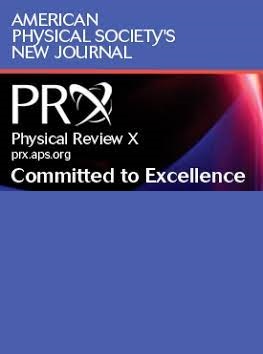Experimental Mode-Pairing Quantum Key Distribution Surpassing the Repeaterless Bound
IF 15.7
1区 物理与天体物理
Q1 PHYSICS, MULTIDISCIPLINARY
引用次数: 0
Abstract
Quantum key distribution (QKD) provides information-theoretic security for communication. The mode-pairing (MP) protocol emerges as a promising solution for long-distance QKD by eliminating the need for a global phase reference while maintaining the repeaterlike rate-loss scaling. Recent implementations have demonstrated its potential, but they either rely on costly ultrastable lasers or struggle with phase fluctuations from commercial lasers, particularly over long distances. As a result, surpassing the repeaterless bound with a practical system remains a challenge. In this work, we demonstrate a practical high-performance MP-QKD system using commercial lasers. To address phase fluctuations, we propose a frequency-tracking scheme based on fast Fourier transformation, enabling us to extend the pairing length to 2×105 pulses (超越无中继器边界的实验模式配对量子密钥分配
量子密钥分发(QKD)为通信提供了信息理论上的安全性。模式配对(MP)协议消除了对全局相位参考的需求,同时保持了类似中继器的速率损失缩放,成为长距离QKD的一种有前途的解决方案。最近的实现已经证明了它的潜力,但它们要么依赖于昂贵的超稳定激光器,要么与商业激光器的相位波动作斗争,特别是在长距离上。因此,在实际系统中超越无重复的界限仍然是一个挑战。在这项工作中,我们展示了一个实用的高性能MP-QKD系统,使用商用激光器。为了解决相位波动问题,我们提出了一种基于快速傅立叶变换的频率跟踪方案,使我们能够将配对长度扩展到2×105脉冲(160 μs)。我们提出了一个模型来仔细分析相位噪声并优化系统参数。我们的系统在403公里的标准光纤中实现了47.8比特/秒的最佳密钥速率(76.5 dB损耗),比无中继器边界高出2.92倍。此外,我们还比较了MP-QKD和双域QKD在各种实际条件下的性能,明确了两种协议的不同应用场景。这些结果证实了MP-QKD使用具有成本效益的商业技术的可行性,为可扩展的量子通信网络铺平了道路。2025年由美国物理学会出版
本文章由计算机程序翻译,如有差异,请以英文原文为准。
求助全文
约1分钟内获得全文
求助全文
来源期刊

Physical Review X
PHYSICS, MULTIDISCIPLINARY-
CiteScore
24.60
自引率
1.60%
发文量
197
审稿时长
3 months
期刊介绍:
Physical Review X (PRX) stands as an exclusively online, fully open-access journal, emphasizing innovation, quality, and enduring impact in the scientific content it disseminates. Devoted to showcasing a curated selection of papers from pure, applied, and interdisciplinary physics, PRX aims to feature work with the potential to shape current and future research while leaving a lasting and profound impact in their respective fields. Encompassing the entire spectrum of physics subject areas, PRX places a special focus on groundbreaking interdisciplinary research with broad-reaching influence.
 求助内容:
求助内容: 应助结果提醒方式:
应助结果提醒方式:


